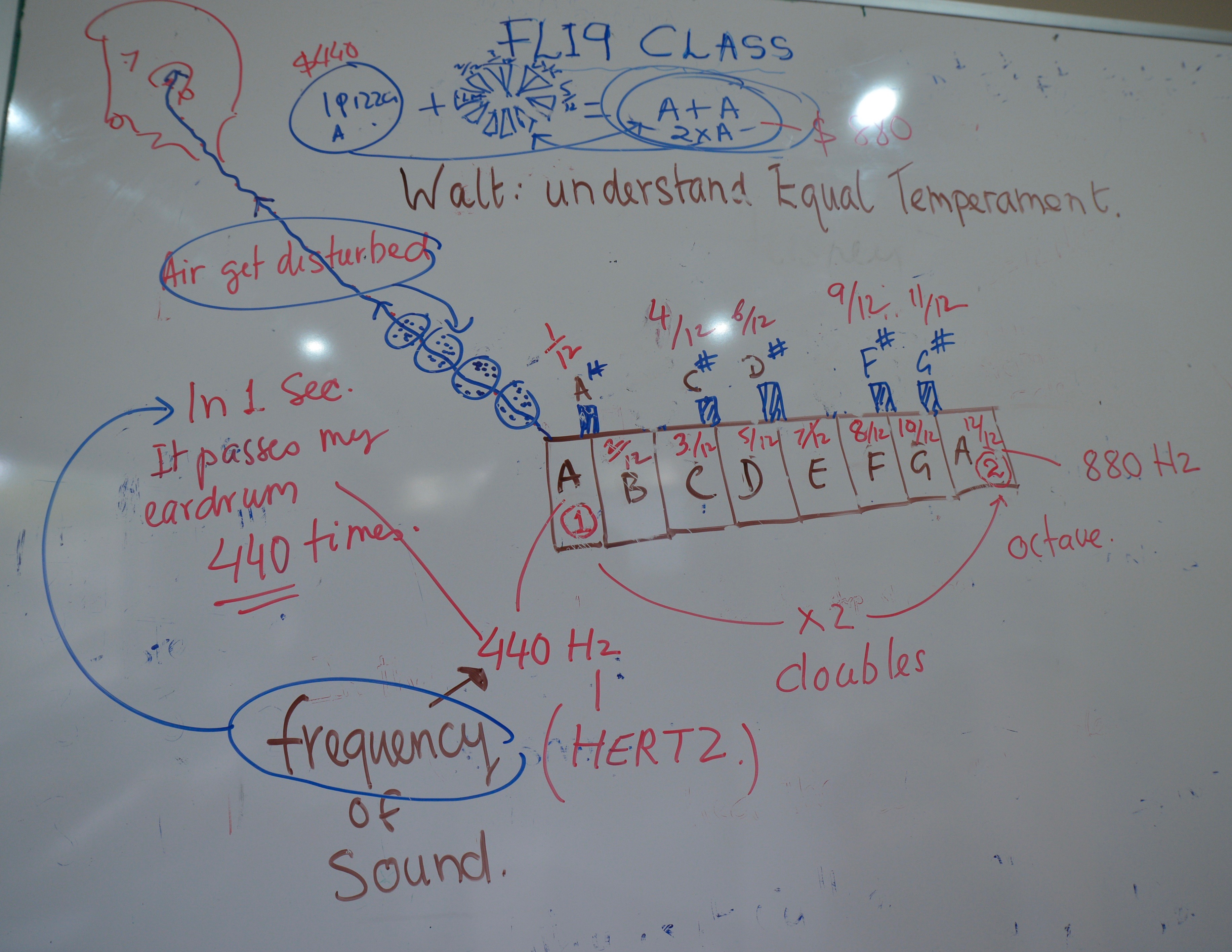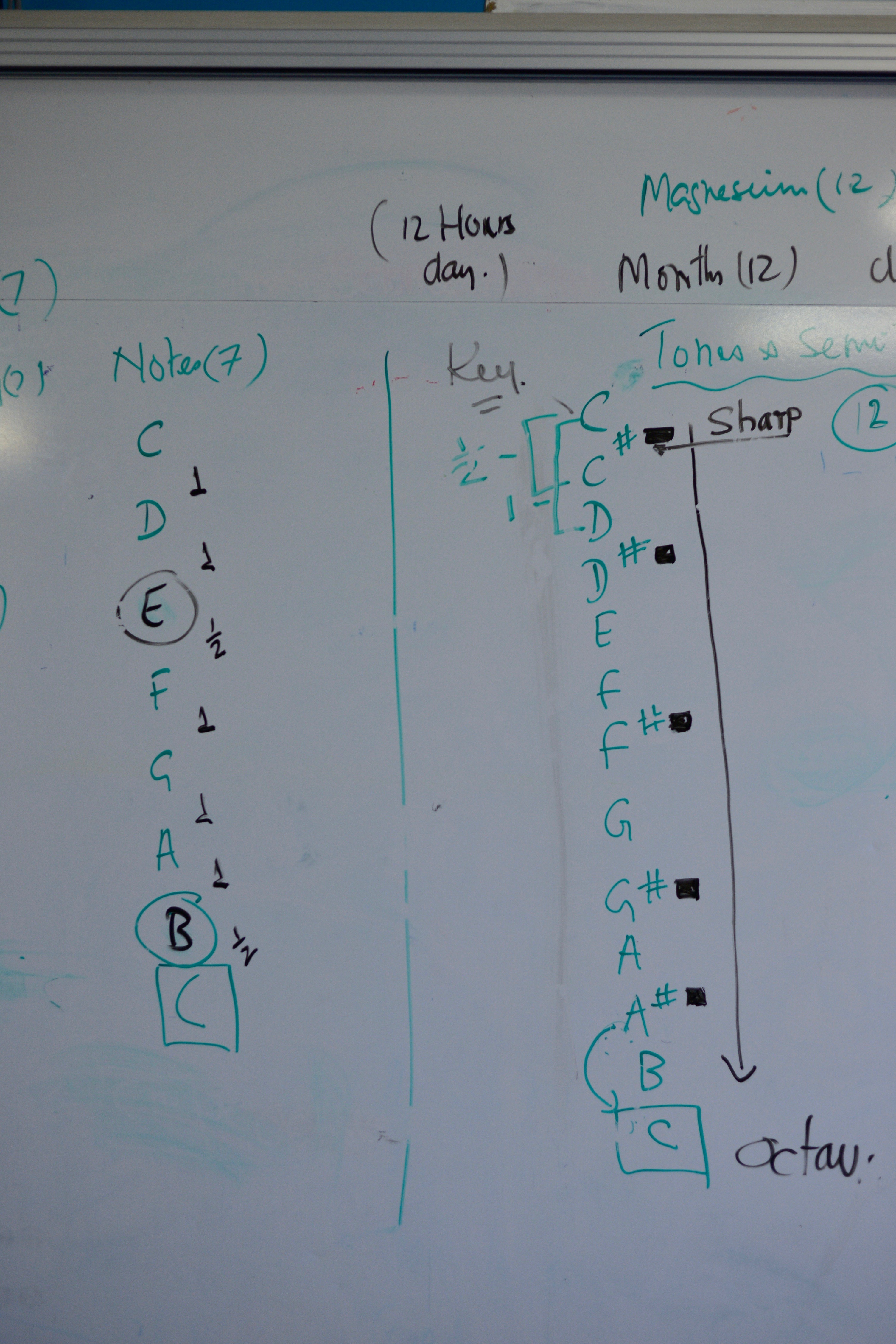8W1 Mathematics
Section outline
-
Kia ora
A warm welcome to all my maths and science students in Y8W1.
The context for Maths and science for this term is My place to stand here in Auckland (with Art specialist subject).
I am attaching the photo of the class whiteboard with the learning intention and the success criteria and the tasks completed during session. Please copy this in your science exercise books and read through the classwork to retain information to create long term memory. I will check your books and mark them.
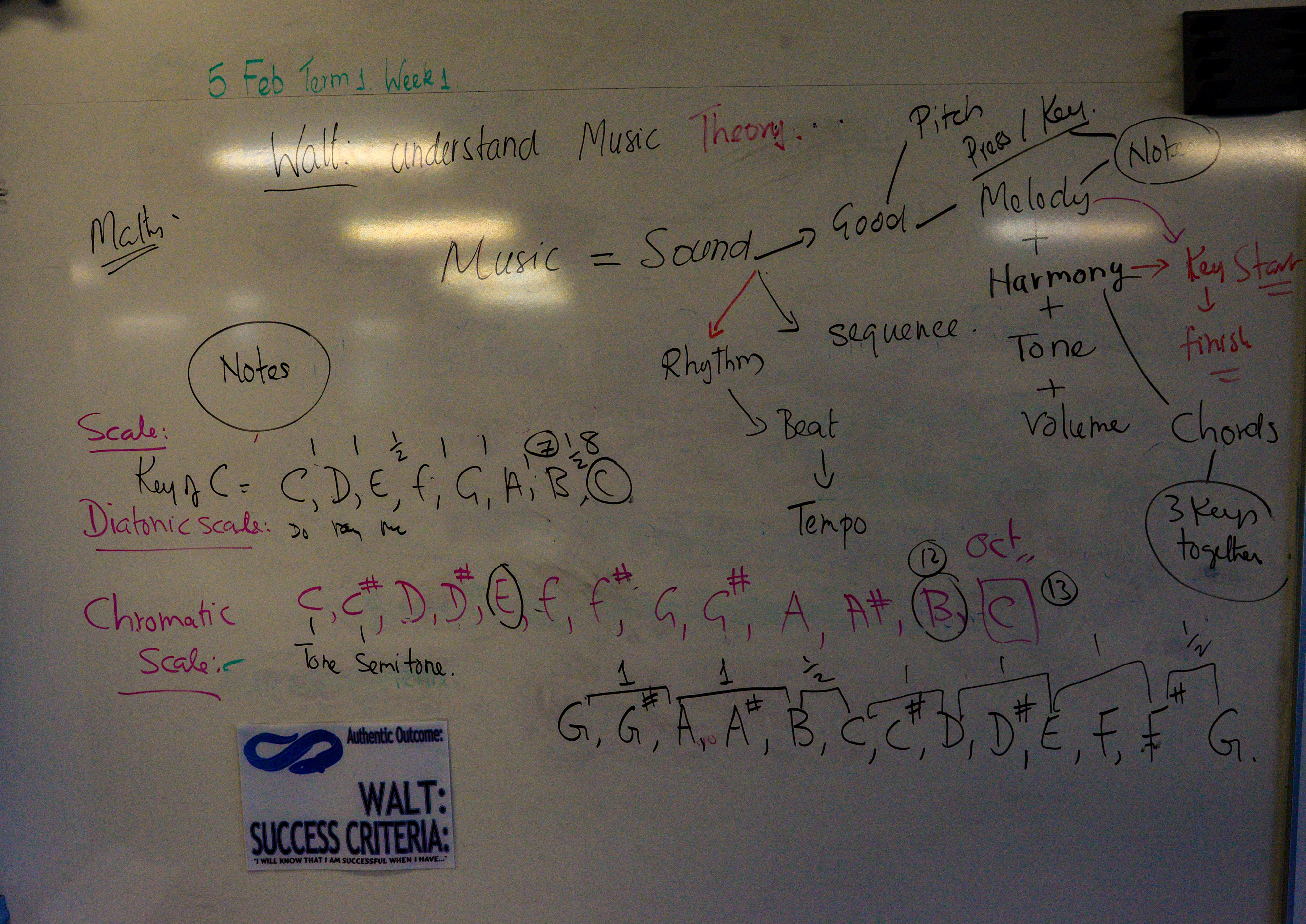
Success Criteria: I can/have...
- Mind map and add to my mind map new information
- recall new learning using mind maps, revision at home to retain information
- build on new information to my prior knowledge
- connect science to maths and other learning areas
Activities:
1. Listening skills - and note taking skill- mind mapping
2. Questioning, making sense of new information, researching and adding to mindmap
3. practice the chromatic scale (12 notes) and the diatonic scale (7 notes) on your device
4. Do re me in the key of C
5. Do re me in the key of G
6. Discover the difference
Follow Up Tasks:
- Copy the image above onto your Maths exercise book.
- Read and understand how we learn.
- Remember by recalling and retelling to your parents and teachers everyday.
- Home learning every day for 1 hour minimum every day, no excuses to create a habit
EXPLORE / TŪHURA learning intentions:
- We are EXPLORING... a scale to investigate the relationship between the length of a string on an instrument and the sound it produces
- We are EXPLORING... connect a mathematical rule to the scale
- We are EXPLORING... investigate notation in music and numbers to interpret notes in music and the value of a number in maths
- We are EXPLORING... 2D and 3D shapes using materials and measures to calculate area, perimeter, volume, capacity, mass, lengths, surface area
-
Kia ora.
Learning Intentions: We are learning to (WALT)...
- L4. explore, describe, and represent patterns and trends for everyday examples of physical phenomena, such as sound
- explore frequency of sound- vibrating at certain frequency - - ears - change in air pressure, notes
- relationship between frequency and notes musical scale
- ratio between each tone and semitone's frequency
- explore the diatonic and the chromatic scale
- explore Do re mi in the C major scale - no sharps - discover the pattern
- create a rule for the other keys in the c Major scale - no. of sharps
- explore why there can be no duplication of tones or semitones in a scale - intro of flats on the F major scale
- Create a rule to make chords for each major chord
- explore the A minor scale - no sharps - discover the pattern
- create a rule for the other keys on the A minor scale
- Create a rule to make chords for each minor scale
- write lyrics with matching chords - 2 verses
- translate lyrics to Maori, play an instrument and sing
Success Criteria: I can/have...
- notes, tones and semitones - identify and play
- calculate the intervals as fractions between each semitones
- convert the intervals as fractional exponent
- understand octave as the 8th note and as the 13th tone
- calculate intervals as fractional power
- calculate ratio of the frequency between each tone and semitone
- calculate by the exponential value of each tone, semitone converting fractional power to its square root function
Activities:
- Guitar, keyboard - explore notes, Do re mi fa so la ti do. Its meaning. Why Do re me?
- Octave? The eighth note. What happens?
- Chord? What are they?
- Tones and semitones - vibrations of different length of the same string
- sound - creation, propagation, frequency, pitch, frequency
- explore notes and ways you could demonstrate to play Do re me
- explore the c major scale
- explore the a minor scale
- compare the C Maj to the A Minor scale
- Create chords using the rule
- Use chords using the rule to apply to lyrics
Follow Up Tasks:
1. HW. mathsbuddy begins Sun 8am tofollowing Sun 8am.2. Copy mindmap to exercise book.
3. Complete Diatonic and chromatic scale on spreadsheet and create major and minor chords.
-
Term Break.
-
Term break.
-
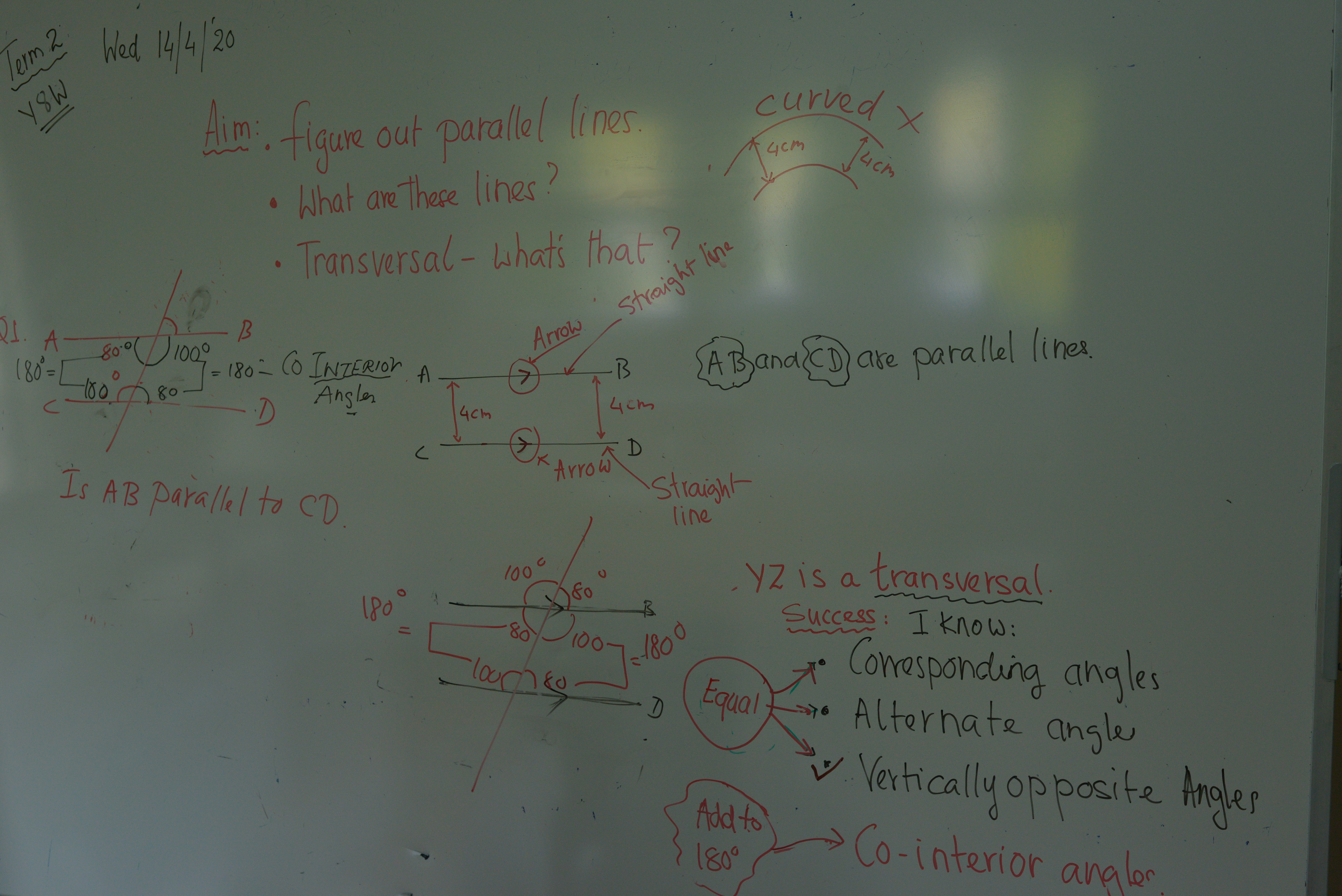 Hi allHope all of you are well. Please keep us informed about your well being. Keep smiling, not long now till we are back at school. Remember to get plenty of fresh air, exercise, practise mindfulness like we do in class and encourage your family to do the same. Go easy on the chips, sugary foods and fizzy drinks.LI: managing self with mathsbuddy and Ed Perfect tasks.Revisit parallel lines and the rules when cut by a transversalWhat are rules?Do Now: All tasks on Mathsbuddy and Ed perfect are online.complete task on whiteboard and complete diagram.Further learning: Any problems you cannot solve please email me the screenshots of the task and as usual I will reply with the working out or we can solve for you during online sessions.Make sure you mark the roll before the session.I will send you the google meet link at the start of each session.
Hi allHope all of you are well. Please keep us informed about your well being. Keep smiling, not long now till we are back at school. Remember to get plenty of fresh air, exercise, practise mindfulness like we do in class and encourage your family to do the same. Go easy on the chips, sugary foods and fizzy drinks.LI: managing self with mathsbuddy and Ed Perfect tasks.Revisit parallel lines and the rules when cut by a transversalWhat are rules?Do Now: All tasks on Mathsbuddy and Ed perfect are online.complete task on whiteboard and complete diagram.Further learning: Any problems you cannot solve please email me the screenshots of the task and as usual I will reply with the working out or we can solve for you during online sessions.Make sure you mark the roll before the session.I will send you the google meet link at the start of each session. -
 a
a Hi allPlease open your email everyday for daily updates and lesson plans.The Monkey mind. - control the monkey through Mindfulness: Stretch, breathe, close your eyes. Focus on your breath for 5 mins. This practise helps you stay focused on the present, not the past or the future which our mind normally does.LI: use the step by step method as a reasoning tool to solve mathematical problems.Activity: Maths buddy for 10 mins.Solve and balance linear equationsApplication: draw graphs for linear equations to understand what the gradient of a straight line means and its use in statistics.SC: Balance equations, terminology, create graphs.Further learning: Mathsbuddy tasks Sun to Sun.Ed Perfect tasks Wed to Wed.Folder with screenshots of unanswered tasks.
Hi allPlease open your email everyday for daily updates and lesson plans.The Monkey mind. - control the monkey through Mindfulness: Stretch, breathe, close your eyes. Focus on your breath for 5 mins. This practise helps you stay focused on the present, not the past or the future which our mind normally does.LI: use the step by step method as a reasoning tool to solve mathematical problems.Activity: Maths buddy for 10 mins.Solve and balance linear equationsApplication: draw graphs for linear equations to understand what the gradient of a straight line means and its use in statistics.SC: Balance equations, terminology, create graphs.Further learning: Mathsbuddy tasks Sun to Sun.Ed Perfect tasks Wed to Wed.Folder with screenshots of unanswered tasks. -
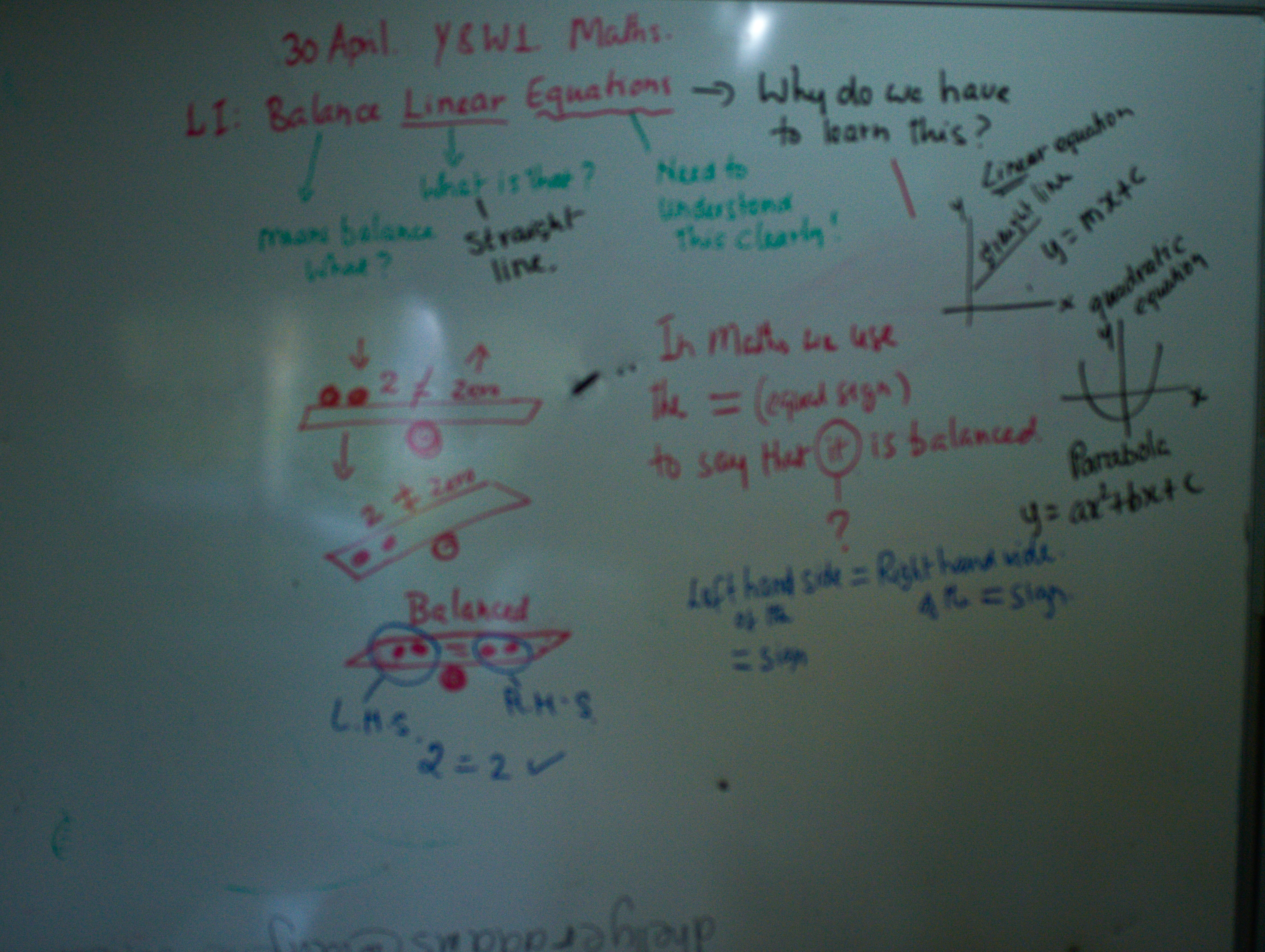 Good morning allPlease open your email daily for the day's lesson plan.Y8W1 https://meet.google.com/
Good morning allPlease open your email daily for the day's lesson plan.Y8W1 https://meet.google.com/lookup/eqnl2kpjf6
8:30 - 8:45. Wellbeing - Sit with a straight back. Close eyes. Relax. Pay attention to your breathing. This allows your mind to stay focused in the present moment. It is only in the present moment that the brain begins to learn.LI: Balancing simple linear equationsTask: warm up: Maths buddy for 10 minsWhiteboard problems on equations from last week'sMapping algebra's pathways from Y10, Y9, to Y8. Why we learn, what we learn and how.Introduction: linear graphSC: Balance simple linear equations using reasoning.Application: Straight line graphFurther learning: Mathsbuddy tasks Sun to Sun.Ed Perfect tasks Wed to Wed.Folder with screenshots of unanswered tasks. -
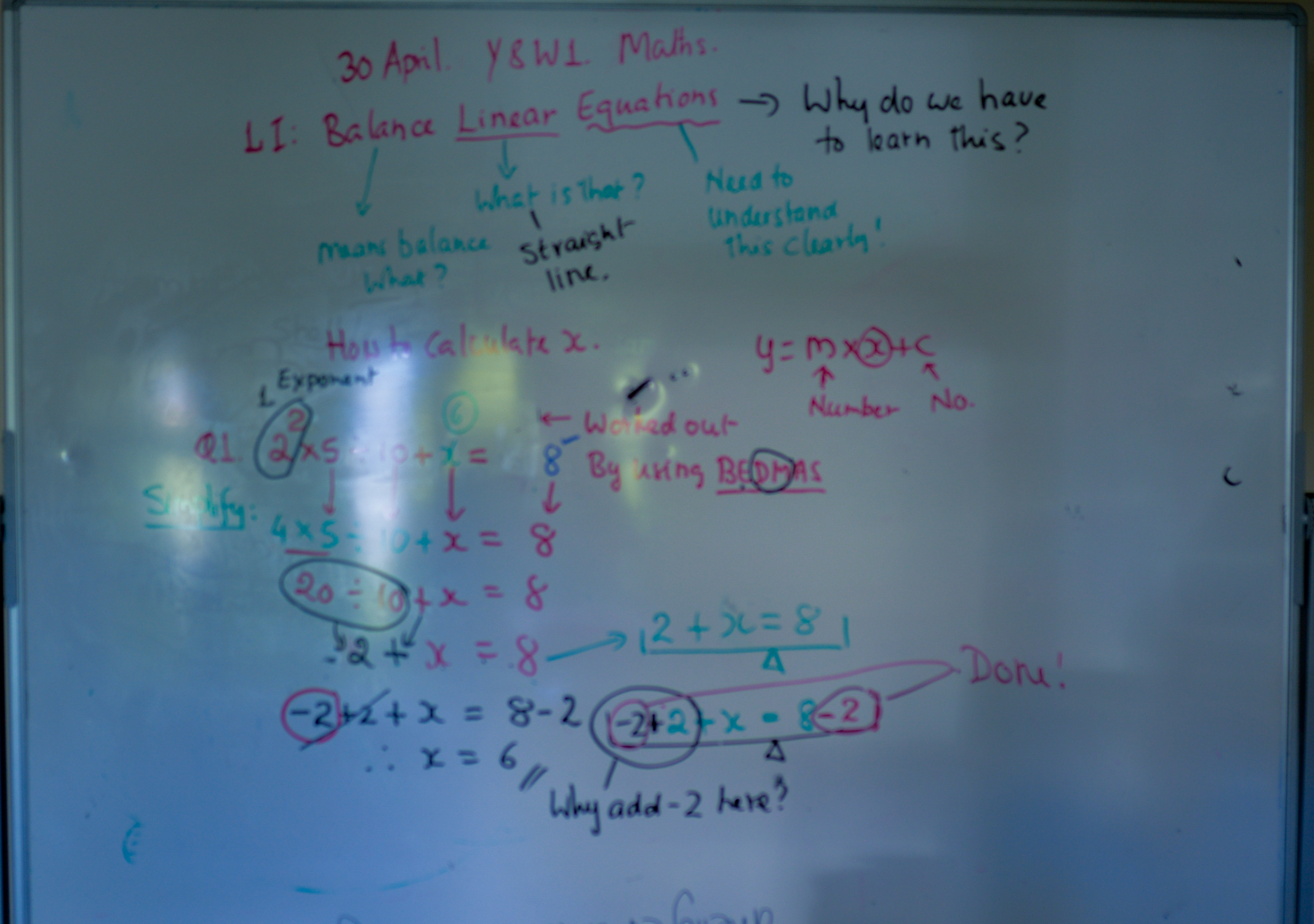 Good morning allPlease open your email daily for the day's lesson plan.Y8W1 https://meet.google.com/
Good morning allPlease open your email daily for the day's lesson plan.Y8W1 https://meet.google.com/lookup/eqnl2kpjf6
8:30 - 8:45. Wellbeing - Sit with a straight back. Close eyes. Relax. Pay attention to your breathing. This allows your mind to stay focused in the present moment. It is only in the present moment that the brain begins to learn.LI: investigate simple linear equations and its application in statisticsTask: Warm up: mathsbuddy 10 mins. Solutions to difficult questionsDo Now: solving questions from last lessons - revivisit 10minsNext step - linear equations - application -straight line graph: y =mx+c what is it?Draw graph using the table methodDraw graph using the triangle methodUse the equation to draw the graph - negative and positiveUse the graph to write the equation - negative and positivecomparing straight line to parabola - the differenceSC: I can: Draw graph using the table methodDraw graph using the triangle methodUse the equation to draw the graph - negative and positiveUse the graph to write the equation - negative and positivecompare straight line graph to a parabola - extension of the negative coordinatesFurther learning: Mathsbuddy tasks Sun to Sun.Ed Perfect tasks Wed to Wed.Folder with screenshots of unanswered tasks. -
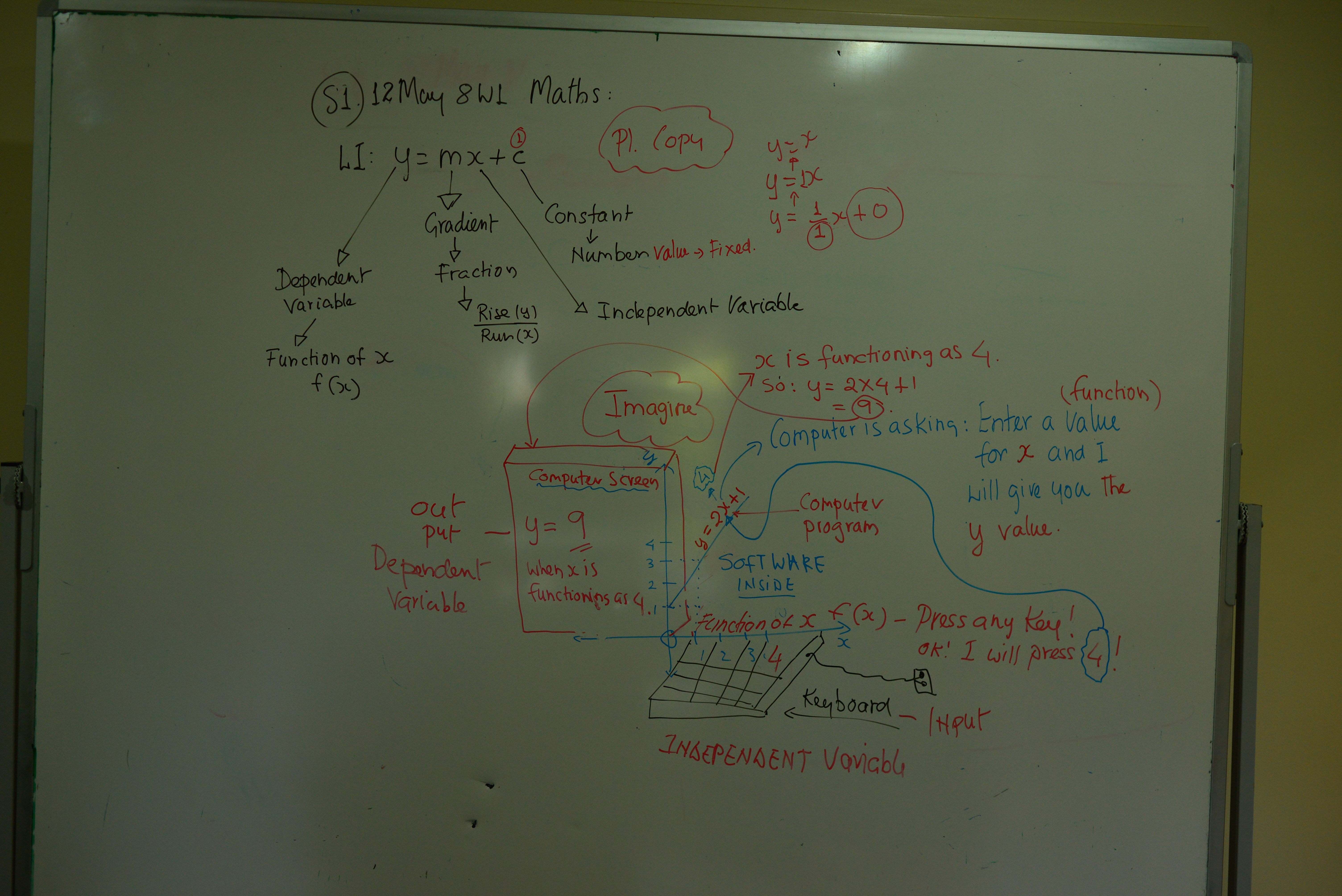 Good morning allPlease open your email daily for the lesson plan.Y8W1 https://meet.google.com/
Good morning allPlease open your email daily for the lesson plan.Y8W1 https://meet.google.com/lookup/eqnl2kpjf6
8:30 - 8:45. Wellbeing - Sit with a straight back. Close eyes. Relax. Pay attention to your breathing. This allows your mind to stay focused in the present moment. It is only in the present moment that the brain begins to learn.LI: investigate simple linear equations and its applicationTask: Warm up: mathsbuddy 10 mins. Solutions to difficult questionsDo Now: solving questions from last lessons - revivisit 10minslinear equations -straight line graph: y =mx+c what is it? last week. Done.Method: triangle method and table method to draw the gradient. Done.Negative and positive gradient . Done.Today: Application of y=mx+c in statistics in context:The why and the how.Independent, dependent variables, correlation between x and y, linear relationship - unpack.SC: I can: Figure out what the graph is telling me in contextConnect the graph to create the equationUse the equation to make a call, to predict probable outcomes.Further learning: Mathsbuddy tasks Sun to Sun.Ed Perfect tasks Wed to Wed.Folder with screenshots of unanswered tasks. -
Term 2 Week 6 This term has 12 weeks.
Kia ora
Welcome back to school for Term 2 Week 6. This term has 12 weeks. So we have 7 weeks of school left for Term 2.
LI: Managing self. Completing Distance learning tasks. Please open your email and in your inbox you will find a spreadsheet in Google classroom. Please read carefully and begin ticking the boxes after you have completed the tasks mentioned in the spreadsheet.
Success Criteria: I can/have...
- I can: manage myself by monitoring my work by:
- completing all maths buddy tasks set during distance learning
- complete all Maths Ed Perfect tasks set during distance learning
- show evidence of my work done during distance learning in Maths in my maths book
- describe and explain linear equations and solve problems in context using y=mx+c for Stats.
Activities:
- Refer to the spreadsheet in Google classroom and begin completing all incomplete work
- Tick the boxes in the spreadsheet as and when the tasks are completed
- Ask for help from me or other students for completion of tasks.
Follow Up Tasks:
For students who have complete all pending tasks:1. In your group - introduction to statistics.
LI: Managing self/ stats - PPDAC cycle
Days Group 1 Group 2 Group 3 Evaluation Mon PPDAC: Pose question complete distance learning complete distance learning Tue Fri
-
Term 2 Week 7. This term has 12 weeks.
Kia ora
Welcome back to school for Term 2 Week 7. This term has 12 weeks. So we have 6 weeks of school left for Term 2.
LI: Managing self. Completing Distance learning tasks. Please open your email and in your inbox you will find a spreadsheet in Google classroom. Please read carefully and begin ticking the boxes after you have completed the tasks mentioned in the spreadsheet.
Success Criteria: I can/have...
- I can: manage myself by monitoring my work by:
- completing all maths buddy tasks set during distance learning
- complete all Maths Ed Perfect tasks set during distance learning
- show evidence of my work done during distance learning in Maths in my maths book
- describe and explain linear equations and solve problems in context using y=mx+c for Stats.
Activities:
- Refer to the spreadsheet in Google classroom and begin completing all incomplete work
- Tick the boxes in the spreadsheet as and when the tasks are completed
- Ask for help from me or other students for completion of tasks.
Follow Up Tasks:
For students who have complete all pending tasks:1. In your group - introduction to statistics.
LI: Managing self/ stats - PPDAC cycle
Days Group 1 Group 2 Group 3 Evaluation Mon PPDAC: Pose question complete distance learning complete distance learning Tue data PPDAC: Pose question PPDAC: Pose question Fri Plan data data
-
Term 2 Week 8. This term has 12 weeks.
Kia ora
This term has 12 weeks. So we have 5 weeks of school left for Term 2.
LI: Focus: to apply Maths to music.
Task: Term 1 Assessment week - application of maths to music.
Success Criteria: I can/have...
- recall C major chromatic scale and the diatonic scale using the mathematical pattern
- recall the major and minor scale using the mathematical pattern
- create major chords using a mathematical rule
- create minor chords using mathematical rule
- recall the sequence of sharps and flats for both the major and minor notes
- work out the ratio between the notes in a major and minor chords and how to change from major to minor and vice versa
- understand octave as the 8th note
- understand the sequence of major, minor and diminished chords for a given song
- understand and apply the 12th root of 2 to calculate the equal tempered chromatic scale
- calculate the note from a given frequency using the equal temperament scale
- write a song with its chords, beat and convert the song into Te Reo Maori
- Activities:
- Refer to the music spreadsheet in Google classroom and begin completing all incomplete work
- practise song with instrument for assessment.
- Complete written assessment.
Follow Up Tasks:
For students who have complete all pending tasks:1. In your group - introduction to statistics.
LI: Managing self/ stats - PPDAC cycle
Days Group 1 Group 2 Group 3 Evaluation Mon written test written test written test resub for WT. Tue singing with instrument singing with instrument singing with instrument Fri singing with instrument singing with instrument singing with instrument
-
EXPLORE / TŪHURA learning intentions:
- We are EXPLORING...to investigate our fitness levels at Lockdown and post Lockdown
- We are EXPLORING...to Analyse and interpret our data set
- We are EXPLORING...to Display our data using appropriate graphs
- We are EXPLORING...to collaborate with PE
-
EXPLORE / TŪHURA learning intentions:
- We are EXPLORING...to Analyse and interpret our data sets
- We are EXPLORING...to collaborate with PE
Success Criteria: I can
- unpack the PPDAC cycle
- understand the meaning of data and the types
- understand the meaning of variable, the independent and the dependent
Activities:
- unpack PPDAC cycle
- discussions on types of data, cleaning of data, outliers, method, random, unbiased,
- creating tally charts,data table, frequency table to enter data
Follow Up Tasks:
1. On task with Mathsbuddy and Education perfect.
-
EXPLORE / TŪHURA learning intentions:
- We are EXPLORING...to Analyse and interpret our data sets
- We are EXPLORING...to collaborate with PE
-
Success Criteria: I can
- unpack the PPDAC cycle
- understand the meaning of data and the types
- understand the meaning of variable, the independent and the dependent
Activities:
- unpack PPDAC cycle
- discussions on types of data, cleaning of data, outliers, method, random, unbiased,
- creating tally charts,data table, frequency table to enter data
Follow Up Tasks:
1. On task with Mathsbuddy and Education perfect.
-
EXPLORE / TŪHURA learning intentions:
- We are EXPLORING...to Analyse and interpret our data sets
- We are EXPLORING...to collaborate with PE
-
Success Criteria: I can
- unpack the PPDAC cycle
- understand the meaning of data and the types
- understand the meaning of variable, the independent and the dependent
Activities:
- unpack PPDAC cycle
- discussions on types of data, cleaning of data, outliers, method, random, unbiased,
- creating tally charts,data table, frequency table to enter data
Follow Up Tasks:
1. On task with Mathsbuddy and Education perfect.
-
Term Break.
-
Term Break.
-
EXPLORE / TŪHURA learning intentions:
- We are EXPLORING...to Analyse and interpret our data sets
- We are EXPLORING...to collaborate with PE
-
Success Criteria: I can
- unpack the PPDAC cycle
- understand the meaning of data and the types
- understand the meaning of variable, the independent and the dependent
- Collect data set from PE class beep test
- Clean data
- Create graphs
- analysis of graphs
- conclusion - answer posed question
Activities:
- unpack PPDAC cycle
- discussions on types of data, cleaning of data, outliers, method, random, unbiased,
- creating tally charts,data table, frequency table to enter data
- create graphs
- analysis what I can see on the graphs.
Follow Up Tasks:
1. On task with Mathsbuddy and Education perfect.
-
EXPLORE / TŪHURA learning intentions:
- We are EXPLORING...to Analyse and interpret our data sets
- We are EXPLORING...to collaborate with PE
-
Success Criteria: I can
- unpack the PPDAC cycle
- understand the meaning of data and the types
- understand the meaning of variable, the independent and the dependent
- create graphs
- analyze graphs
- Compare graphs pre and post data sets
- Compare to National average
Activities:
- unpack PPDAC cycle
- discussions on types of data, cleaning of data, outliers, method, random, unbiased,
- creating tally charts,data table, frequency table to enter data
- collect data from PE
- clean data
- graph and analysis
- repeat PPDAC for comparison between pre and post.
Follow Up Tasks:
1. On task with Mathsbuddy and Education perfect.
-
EXPLORE / TŪHURA learning intentions:
- We are EXPLORING...to Analyse and interpret our data sets
- We are EXPLORING...to collaborate with PE
Success Criteria: I can
- unpack the PPDAC cycle
- understand the meaning of data and the types
- understand the meaning of variable, the independent and the dependent
- create graphs
- analyze graphs
- Compare graphs pre and post data sets
- Compare to National average
Activities:
- unpack PPDAC cycle
- discussions on types of data, cleaning of data, outliers, method, random, unbiased,
- creating tally charts,data table, frequency table to enter data
- collect data from PE
- clean data
- graph and analysis
- repeat PPDAC for comparison between pre and post.
Follow Up Tasks:
1. On task with Mathsbuddy and Education perfect.
-
Lock down Week.
-
Kia ora
We are in lockdown L3. So all learning will be on line through distance learning.
Success Criteria: I can/have...
- Managing self:
- Using Google Meet to meet the teachers and completing the journal and the grid timetable on a daily basis.
- Feedback will be given as and when students complete their assigned tasks in their journals.
Activities:
- Journal entries every day
- Completing tasks as assigned on the Grid timetable.
Follow Up Tasks:
1. Meeting your LA teacher on Google meet on Fridays.2. Meeting your subject teachers for help on Google Meet.
-
Kia ora
We are in lockdown L3. So all learning will be on line through distance learning.
Success Criteria: I can/have...
- Managing self:
- Using Google Meet to meet the teachers and completing the journal and the grid timetable on a daily basis.
- Feedback will be given as and when students complete their assigned tasks in their journals.
Activities:
- Journal entries every day
- Completing tasks as assigned on the Grid timetable.
Follow Up Tasks:
1. Meeting your LA teacher on Google meet on Fridays.2. Meeting your subject teachers for help on Google Meet.
-
Kia ora class
This week you will be completing all pending tasks on Monday.
You will enter the classroom from the sliding doors and sit on the assigned seats for the week.
The teachers will be coming to your class while you stay seated in your homebase for the whole week.
Plan for the week:
1. Monday: Complete all pending tasks.
Term 1. SLC reflection.
2. Holistic report reflection.
3. SLC slideshow
4. GREAT learner evidence - Holistic report
5. Maths buddy/ Reading plus HW up to date.
DEEP: No DEEP classes for the WEEK. Return to LA class to complete 1, 2, 3, 4.
TUE, WED, THU, FRI - regular timetabled classes.
Success Criteria: I can/have...
- I can: Manage self with the distance learning tasks from the two week period.
- Complete all of the above
- Connect with other teachers for help with my work.
Activities:
- Begin completing the tasks on the grid and Engagement tracker every day.
- Complete all online HW tasks
- Complete all of the above mentioned tasks
Follow Up Tasks:
1. Check journal for completion with photos as evidence2. Current Mathsbuddy, Ed Perfect, Reading plus.
3. Read teacher's feedback on Journal and action it.
link to the grid and Journal:https://docs.google.com/document/d/1FsBw6DYcgwXc3xS8t6o5Q4iSJHIYlDkO39i9uGcfMSE/edit
-
EXPLORE / TŪHURA learning intentions:
- We are EXPLORING...units by interpreting different quantities
- We are EXPLORING.... units conversions by connecting different units
- We are EXPLORING...Area/Perimeter by collecting measurements of the Netball court
- We are EXPLORING...Volume by experimenting using measuring cylinder
- We are EXPLORING...Angles by measuring/drawing using a protractor
-
Success Criteria: I can/have...
- Use units of measurements of lengths and angles to calculate side lengths and angles using a protractor of 2D shapes
- calculate the area of 2D shapes and create a rule
- calculate the perimeter of 2D shapes and create a rule
- Understand signs and symbols in maths for equal, lengths, congruent
- understand hypotenuse and the rules of a right angled triangle
- understand how letters represent numbers
- Recall - coefficient, squared, power, indices, exponent, variable, constant, equation, expression, terms, lika dn unlike terms and the rues they must follow.
Activities:
- Make a kite
- Look at the pattern, mirror image etc.
- What is equal? Calculate, measure lengths and angles
- How many triangles? Area/? Perimeter? Congruent?
Follow Up Tasks:
Mathsbuddy, EP maths, recap lesson for next class.
-
EXPLORE / TŪHURA learning intentions:
- We are EXPLORING...units by interpreting different quantities
- We are EXPLORING.... units conversions by connecting different units
- We are EXPLORING...Area/Perimeter by collecting measurements of the Netball court
- We are EXPLORING...Volume by experimenting using measuring cylinder
- We are EXPLORING...Angles by measuring/drawing using a protractor
Success Criteria: I can/have...
- Use units of measurements of lengths and angles to calculate side lengths and angles using a protractor of 2D shapes
- calculate the area of 2D shapes and create a rule
- calculate the perimeter of 2D shapes and create a rule
- Understand signs and symbols in maths for equal, lengths, congruent
- understand hypotenuse and the rules of a right angled triangle
- understand how letters represent numbers
- Recall - coefficient, squared, power, indices, exponent, variable, constant, equation, expression, terms, lika dn unlike terms and the rues they must follow.
Activities:
- Make a kite
- Look at the pattern, mirror image etc.
- What is equal? Calculate, measure lengths and angles
- How many triangles? Area/? Perimeter? Congruent?
Follow Up Tasks:
Mathsbuddy, EP maths, recap lesson for next class. -
EXPLORE / TŪHURA learning intentions:
- We are EXPLORING Algebra by finding and representing relationships in spatial and number patterns, using tables and graphs and by discovering general rules for linear relationships.
- We are EXPLORING units by interpreting different quantities
- We are EXPLORING unit conversions by connecting different units
- We are EXPLORING Area, perimeter and volume of 2D and 3D shapes
-
Success Criteria: I can/have...
- Use units of measurements of lengths and angles to calculate side lengths and angles using a protractor of 2D shapes
- calculate the area of 2D shapes and create a rule
- calculate the perimeter of 2D shapes and create a rule
- Understand signs and symbols in maths for equal, lengths, congruent
- understand hypotenuse and the rules of a right angled triangle
- understand how letters represent numbers
- Recall - coefficient, squared, power, indices, exponent, variable, constant, equation, expression, terms, lika dn unlike terms and the rues they must follow.
Activities:
- Make a kite
- Look at the pattern, mirror image etc.
- What is equal? Calculate, measure lengths and angles
- How many triangles? Area/? Perimeter? Congruent?
- use Sphero to calculate bearings and directions
- program Sphero to enter 3 figure bearings to draw geometric shapes
- calculate perimeter, area, speed, distance, time and then create a rule
- calculate the unknown length of a right angled triangle and then create a rule
- For extension students: use trig ratio to calculate angle
Follow Up Tasks:
Mathsbuddy, EP maths, recap lesson for next class.
-
EXPLORE / TŪHURA learning intentions:
- We are EXPLORING Algebra by finding and representing relationships in spatial and number patterns, using tables and graphs and by discovering general rules for linear relationships.
- We are EXPLORING units by interpreting different quantities
- We are EXPLORING unit conversions by connecting different units
-
Success Criteria: I can/have...
- measure distance and angles using standard units of measurements
- use angles and measurements to calculate the unknown side/ length
- identify the hypotenuse, opposite side, adjacent side of a right angled triangle
- identify a right angled isosceles triangles
- understand equal lengths have equal opposite angles in a triangle
- create a rule using right angled triangle for calculating unknown side - Pythagoras rule
- create a proportional rule for similar triangles using a right angled triangle to calculate the height of a wall
- plot coordinates using 3 figure bearings and graph the coordinates
- draw simple linear graphs
- use linear graphs to understand linear equations
- create linear equation rule of y = mx+c from any straight line graph
- using y=mx +c predict the value of y when there is a change in x
Activities:
- Using Spheros plan a route using 3 figure bearings on the playground.
- Create 2 D shapes with spheros calculate angles, lengths, area, perimeter
- calculate speed using distance and time data
- plot a graph for speed using the rule y = mx +c
- use a A4 paper to create a clinometer, ( right angled isosceles triangle)
- use properties of similar triangles to calculate height (proportion)
- Test - review of past week's lessons. Self mark, buddy with higher level students to undo errors.
- Use gravity to calculate the height of the school building and confirm the height measurement by using the similar triangle method
Follow Up Tasks:
1. Complete Maths buddy and Ed Perfect science HW tasks.
-
EXPLORE / TŪHURA learning intentions:
- We are EXPLORING Algebra by finding and representing relationships in spatial and number patterns, using tables and graphs and by discovering general rules for linear relationships.
- We are EXPLORING units by interpreting different quantities
- We are EXPLORING unit conversions by connecting different units
-
Success Criteria: I can/have...
- measure distance and angles using standard units of measurements
- use angles and measurements to calculate the unknown side/ length
- identify the hypotenuse, opposite side, adjacent side of a right angled triangle
- identify a right angled isosceles triangles
- understand equal lengths have equal opposite angles in a triangle
- create a rule using right angled triangle for calculating unknown side - Pythagoras rule
- create a proportional rule for similar triangles using a right angled triangle to calculate the height of a wall
- plot coordinates using 3 figure bearings and graph the coordinates
- draw simple linear graphs
- use linear graphs to understand linear equations
- create linear equation rule of y = mx+c from any straight line graph
- using y=mx +c predict the value of y when there is a change in x
Activities:
- Using Spheros plan a route using 3 figure bearings on the playground.
- Create 2 D shapes with spheros calculate angles, lengths, area, perimeter
- calculate speed using distance and time data
- plot a graph for speed using the rule y = mx +c
- use a A4 paper to create a clinometer, ( right angled isosceles triangle)
- use properties of similar triangles to calculate height (proportion)
- Test - review of past week's lessons. Self mark, buddy with higher level students to undo errors.
- Use gravity to calculate the height of the school building and confirm the height measurement by using the similar triangle method
Follow Up Tasks:
1. Complete Maths buddy and Ed Perfect science HW tasks.
-
EXPLORE / TŪHURA learning intentions:
- We are EXPLORING Algebra by finding and representing relationships in spatial and number patterns, using tables and graphs and by discovering general rules for linear relationships.
- We are EXPLORING units by interpreting different quantities
- We are EXPLORING unit conversions by connecting different units
-
Success Criteria: I can/have...
- measure distance and angles using standard units of measurements
- use angles and measurements to calculate the unknown side/ length
- identify the hypotenuse, opposite side, adjacent side of a right angled triangle
- identify a right angled isosceles triangles
- understand equal lengths have equal opposite angles in a triangle
- create a rule using right angled triangle for calculating unknown side - Pythagoras rule
- create a proportional rule for similar triangles using a right angled triangle to calculate the height of a wall
- plot coordinates using 3 figure bearings and graph the coordinates
- draw simple linear graphs
- use linear graphs to understand linear equations
- create linear equation rule of y = mx+c from any straight line graph
- using y=mx +c predict the value of y when there is a change in x
Activities:
- Using Spheros plan a route using 3 figure bearings on the playground.
- Create 2 D shapes with spheros calculate angles, lengths, area, perimeter
- calculate speed using distance and time data
- plot a graph for speed using the rule y = mx +c
- use a A4 paper to create a clinometer, ( right angled isosceles triangle)
- use properties of similar triangles to calculate height (proportion)
- Test - review of past week's lessons. Self mark, buddy with higher level students to undo errors.
- Use gravity to calculate the height of the school building and confirm the height measurement by using the similar triangle method
Follow Up Tasks:
1. Complete Maths buddy and Ed Perfect science HW tasks.
-
EXPLORE / TŪHURA learning intentions:
- We are EXPLORING.. appropriate scales, devices, and metric units for length, angle, and time.
- We are EXPLORING.... side or edge lengths to find angles and lengths of similar triangles
- We are EXPLORING... scales and ratio
- We are EXPLORING ...simple linear proportions, including fractions and ratio
- We are EXPLORING ...equivalent fractions
- We are EXPLORING ... rules to describe linear relationships and quadratic functions
- WE ARE EXPLORING.. the invariant properties of figures and objects under transformations ( enlargement).
-
Success Criteria: I can/have...
- measure distance and angles using standard units of measurements
- use angles and measurements to calculate the unknown side/ length
- identify the hypotenuse, opposite side, adjacent side of a right angled triangle
- identify a right angled isosceles triangles
- understand equal lengths have equal opposite angles in a triangle
- create a rule using right angled triangle for calculating unknown side - Pythagoras rule
- create a proportional rule for similar triangles using a right angled triangle to calculate the height of a wall
- plot coordinates using 3 figure bearings and graph the coordinates
- draw simple linear graphs
- use linear graphs to understand linear equations
- create linear equation rule of y = mx+c from any straight line graph
- using y=mx +c predict the value of y when there is a change in x
Activities:
- Using Spheros plan a route using 3 figure bearings on the playground.
- Create 2 D shapes with spheros calculate angles, lengths, area, perimeter
- calculate speed using distance and time data
- plot a graph for speed using the rule y = mx +c
- use a A4 paper to create a clinometer, ( right angled isosceles triangle)
- use properties of similar triangles to calculate height (proportion)
- Test - review of past week's lessons. Self mark, buddy with higher level students to undo errors.
- Use gravity to calculate the height of the school building and confirm the height measurement by using the similar triangle method
Follow Up Tasks:
1. Complete Maths buddy and Ed Perfect science HW tasks.
-
EXPLORE / TŪHURA learning intentions:
- We are EXPLORING.. appropriate scales, devices, and metric units for length, angle, and time.
- We are EXPLORING.... side or edge lengths to find angles and lengths of similar triangles
- We are EXPLORING... scales and ratio
- We are EXPLORING ...simple linear proportions, including fractions and ratio
- We are EXPLORING ...equivalent fractions
- We are EXPLORING ... rules to describe linear relationships and quadratic functions
- WE ARE EXPLORING.. the invariant properties of figures and objects under transformations ( enlargement).
Success Criteria: I can/have...
- measure distance and angles using standard units of measurements
- use angles and measurements to calculate the unknown side/ length
- identify the hypotenuse, opposite side, adjacent side of a right angled triangle
- identify a right angled isosceles triangles
- understand equal lengths have equal opposite angles in a triangle
- create a rule using right angled triangle for calculating unknown side - Pythagoras rule
- create a proportional rule for similar triangles using a right angled triangle to calculate the height of a wall
- plot coordinates using 3 figure bearings and graph the coordinates
- draw simple linear graphs
- use linear graphs to understand linear equations
- create linear equation rule of y = mx+c from any straight line graph
- using y=mx +c predict the value of y when there is a change in x
Activities:
- Using Spheros plan a route using 3 figure bearings on the playground.
- Create 2 D shapes with spheros calculate angles, lengths, area, perimeter
- calculate speed using distance and time data
- plot a graph for speed using the rule y = mx +c
- use a A4 paper to create a clinometer, ( right angled isosceles triangle)
- use properties of similar triangles to calculate height (proportion)
- Test - review of past week's lessons. Self mark, buddy with higher level students to undo errors.
- Use gravity to calculate the height of the school building and confirm the height measurement by using the similar triangle method
Follow Up Tasks:
1. Complete Maths buddy and Ed Perfect science HW tasks.
-
EXPLORE / TŪHURA learning intentions:
- We are EXPLORING.. appropriate scales, devices, and metric units for length, angle, and time.
- We are EXPLORING.... side or edge lengths to find angles and lengths of similar triangles
- We are EXPLORING... scales and ratio
- We are EXPLORING ...simple linear proportions, including fractions and ratio
- We are EXPLORING ...equivalent fractions
- We are EXPLORING ... rules to describe linear relationships and quadratic functions
- WE ARE EXPLORING.. the invariant properties of figures and objects under transformations ( enlargement).
-
Success Criteria: I can/have...
- measure distance and angles using standard units of measurements
- use angles and measurements to calculate the unknown side/ length
- identify the hypotenuse, opposite side, adjacent side of a right angled triangle
- identify a right angled isosceles triangles
- understand equal lengths have equal opposite angles in a triangle
- create a rule using right angled triangle for calculating unknown side - Pythagoras rule
- create a proportional rule for similar triangles using a right angled triangle to calculate the height of a wall
- plot coordinates using 3 figure bearings and graph the coordinates
- draw simple linear graphs
- use linear graphs to understand linear equations
- create linear equation rule of y = mx+c from any straight line graph
- using y=mx +c predict the value of y when there is a change in x
Activities:
- Using Spheros plan a route using 3 figure bearings on the playground.
- Create 2 D shapes with spheros calculate angles, lengths, area, perimeter
- calculate speed using distance and time data
- plot a graph for speed using the rule y = mx +c
- use a A4 paper to create a clinometer, ( right angled isosceles triangle)
- use properties of similar triangles to calculate height (proportion)
- Test - review of past week's lessons. Self mark, buddy with higher level students to undo errors.
- Use gravity to calculate the height of the school building and confirm the height measurement by using the similar triangle method
Follow Up Tasks:
1. Complete Maths buddy and Ed Perfect science HW tasks.
-
EXPLORE / TŪHURA learning intentions:
- We are EXPLORING.. appropriate scales, devices, and metric units for length, angle, and time.
- We are EXPLORING.... side or edge lengths to find angles and lengths of similar triangles
- We are EXPLORING... scales and ratio
- We are EXPLORING ...simple linear proportions, including fractions and ratio
- We are EXPLORING ...equivalent fractions
- We are EXPLORING ... rules to describe linear relationships and quadratic functions
- WE ARE EXPLORING.. the invariant properties of figures and objects under transformations ( enlargement).
-
Success Criteria: I can/have...
- measure distance and angles using standard units of measurements
- use angles and measurements to calculate the unknown side/ length
- identify the hypotenuse, opposite side, adjacent side of a right angled triangle
- identify a right angled isosceles triangles
- understand equal lengths have equal opposite angles in a triangle
- create a rule using right angled triangle for calculating unknown side - Pythagoras rule
- create a proportional rule for similar triangles using a right angled triangle to calculate the height of a wall
- plot coordinates using 3 figure bearings and graph the coordinates
- draw simple linear graphs
- use linear graphs to understand linear equations
- create linear equation rule of y = mx+c from any straight line graph
- using y=mx +c predict the value of y when there is a change in x
Activities:
- Using Spheros plan a route using 3 figure bearings on the playground.
- Create 2 D shapes with spheros calculate angles, lengths, area, perimeter
- calculate speed using distance and time data
- plot a graph for speed using the rule y = mx +c
- use a A4 paper to create a clinometer, ( right angled isosceles triangle)
- use properties of similar triangles to calculate height (proportion)
- Test - review of past week's lessons. Self mark, buddy with higher level students to undo errors.
- Use gravity to calculate the height of the school building and confirm the height measurement by using the similar triangle method
Follow Up Tasks:
1. Complete Maths buddy tasks for gaps and to be achieved and Ed Perfect science HW tasks.


